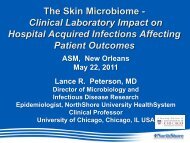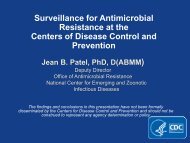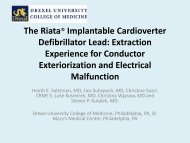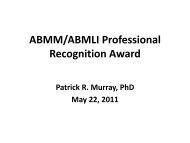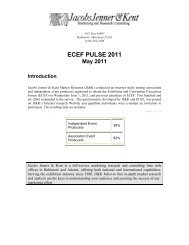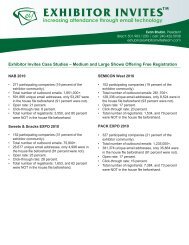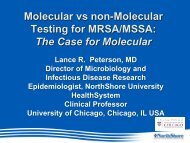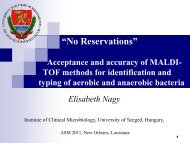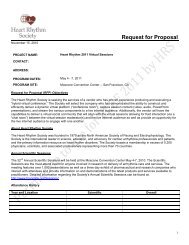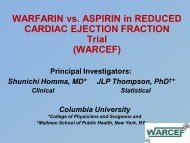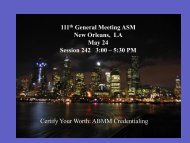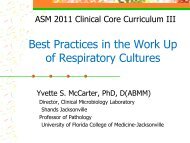Advances in 1st and 2nd Line Drug Susceptibility Testing in ...
Advances in 1st and 2nd Line Drug Susceptibility Testing in ...
Advances in 1st and 2nd Line Drug Susceptibility Testing in ...
Create successful ePaper yourself
Turn your PDF publications into a flip-book with our unique Google optimized e-Paper software.
<strong>Advances</strong> <strong>in</strong> 1 st <strong>and</strong> 2 nd L<strong>in</strong>e <strong>Drug</strong><br />
<strong>Susceptibility</strong> Test<strong>in</strong>g of<br />
Mycobacterium tuberculosis<br />
Alternative title: mix of <strong>in</strong>terest<strong>in</strong>g stuff about drug<br />
susceptibility test<strong>in</strong>g for TB<br />
Edward Desmond, Ph.D., D (ABMM)<br />
San Le<strong>and</strong>ro, CA
Cepheid GeneXpert<br />
What’s new?<br />
Vaya con Dios, BACTEC 12B<br />
Hello, 2 nd l<strong>in</strong>e drugs <strong>in</strong> MGIT<br />
Moxifloxac<strong>in</strong> <strong>in</strong> MGIT<br />
Trek broth MIC system under evaluation<br />
Detect<strong>in</strong>g drug resistance by sequenc<strong>in</strong>g<br />
CDC’s MDDR service (molecular detection of drug<br />
resistance)<br />
Pyrosequenc<strong>in</strong>g<br />
From culture<br />
From sputum sediment<br />
Ethambutol worries
The journey from radioactive<br />
to non-<br />
BD to discont<strong>in</strong>ue production of BACTEC 12B after<br />
Sept. 2011<br />
November, 2009 CDC performance evaluation event<br />
• 59 labs used MGIT as their 1 drug sus test system<br />
• 5 labs used Versa Trek as their 1 drug sus test system<br />
• 23 labs used BACTEC 12B as their 1 drug sus test<br />
system
Can we transition 2 nd l<strong>in</strong>e test<strong>in</strong>g from 12B<br />
to MGIT?<br />
Rusch-Gerdes, S., et al. 2006. JCM 44: 688<br />
Van Ingen, J., et al. 2010. JCM 48: 2749<br />
L<strong>in</strong>, S.Y., et al. 2009. JCM 47: 3630<br />
WHO 2008 Policy guidance on drug-<br />
susceptibility test<strong>in</strong>g (DST) of second-l<strong>in</strong>e<br />
antituberculosis drugs
<strong>Drug</strong> Levofloxac<strong>in</strong> Amikac<strong>in</strong> Capreomyc<strong>in</strong><br />
Concentration<br />
(ug/mL)<br />
MGIT test concentrations<br />
ug/mL 6<br />
Ethionamide<br />
1.5 1.5 3 5<br />
<strong>Drug</strong> Levo Amikac<strong>in</strong> Capreo Ethion<br />
Conc<br />
J. Cl<strong>in</strong>. Microbiol. 2009 47(11)3630-4<br />
WHO 2008 guidel<strong>in</strong>es for MGIT 960<br />
No<br />
recomm.<br />
1.0 2.5 5.0
Inoculat<strong>in</strong>g a MGIT drug sus<br />
test from a primary MGIT tube<br />
BD package <strong>in</strong>sert calls for mix<strong>in</strong>g the MGIT<br />
tube <strong>and</strong> us<strong>in</strong>g a sample of this or a 1:5<br />
dilution of it (day 3 to 5 after positivity) as<br />
<strong>in</strong>oculum<br />
Problem: variable amounts of M. tb cells likely have<br />
been removed for smear <strong>and</strong> AccuProbe<br />
Problem: anecdotes of <strong>in</strong>consistent results<br />
Problem: studies <strong>in</strong> which no M. tb cells were<br />
removed from <strong>in</strong>oculum tube don’t really evaluate<br />
accuracy of this method as performed us<strong>in</strong>g primary<br />
cultures/cl<strong>in</strong>ical isolates<br />
7
Calif. protocol for <strong>in</strong>oculum prep from 1 MGIT<br />
Pipet 2 mL from bottom of primary MGIT tube<br />
<strong>in</strong>to a 1 dram vial & let settle for 20 m<strong>in</strong>.<br />
Pipet supernate to another 1 dram vial & let<br />
settle for 15 m<strong>in</strong><br />
Pipet supernate to another 1 dram vial <strong>and</strong><br />
dilute to McFarl<strong>and</strong> 0.5 us<strong>in</strong>g normal sal<strong>in</strong>e;<br />
dilute 1:5 (or 1:3)<br />
Protocol compensates for variable amounts<br />
removed from primary tube, <strong>and</strong> works with<br />
s<strong>in</strong>gle cells or small clumps<br />
Full disclosure: BD provided free MGIT medium for<br />
evaluation of this protocol (L<strong>in</strong> 2009. JCM 47: 3630)<br />
8
Fall 2010 CDC Model Performance Evaluation<br />
Program (MPEP) results<br />
• 2 cultures sent <strong>in</strong> duplicate<br />
• MGIT showed significantly less ethambutol<br />
resistance than agar or BACTEC 460 methods<br />
• Is ethambutol concentration <strong>in</strong> MGIT too high?<br />
• When proficiency test<strong>in</strong>g reveals a flaw <strong>in</strong> a test<strong>in</strong>g<br />
method, is a laboratory required to repeat the test<strong>in</strong>g<br />
by another method?
Ethambutol <strong>in</strong> MGIT—what to do?<br />
o If there was no consensus <strong>in</strong> test<strong>in</strong>g by the reference method,<br />
no action should be required<br />
o If test<strong>in</strong>g by the reference method did show consensus, <strong>and</strong><br />
your laboratory’s result us<strong>in</strong>g MGIT yielded a different result,<br />
corrective action should be considered<br />
o Wait for report for this event to see what conclusions are
Some mus<strong>in</strong>gs about corrective actions<br />
o May want to repeat test<strong>in</strong>g if false ethambutol<br />
susceptibility is suspected<br />
o Madison, et al. 2002. JCM 40(11):3976-79 showed (table 2)<br />
that 97% of TB isolates that are truly resistant to<br />
ethambutol (by both agar <strong>and</strong> radiometric methods) were<br />
also resistant to INH<br />
o Maybe not necessary to re-test pan-susceptible stra<strong>in</strong>s.<br />
These are very unlikely to be resistant to EMB<br />
o Re-test<strong>in</strong>g of cultures older than 6 months probably not<br />
cl<strong>in</strong>ically relevant—treatment likely completed<br />
o Maybe re-test stra<strong>in</strong>s
Repeat test<strong>in</strong>g to confirm ethambutol<br />
susceptibility<br />
o Re-test<strong>in</strong>g by same method (MGIT) seems<br />
po<strong>in</strong>tless<br />
o Alternative methods would be BACTEC 12B,<br />
agar proportion, or DNA sequenc<strong>in</strong>g,<br />
depend<strong>in</strong>g on which you have <strong>in</strong> your<br />
laboratory
Moxifloxac<strong>in</strong> results compared with LEV<br />
by MGIT 960<br />
MOX<br />
by MGIT 960<br />
LEV-R<br />
By MGIT 960<br />
LEV-S<br />
By MGIT 960<br />
>0.25 ug/ml 40 0<br />
≤ 0.25 ug/ml 0 64<br />
The abstract was presented at 2010 ASM General meet<strong>in</strong>g.
MOX<br />
MIC<br />
(ug/ml)<br />
Mutations ( # of stra<strong>in</strong>s)<br />
90gtg 94gcc 95acc 94ggc 91ccg 94cac 94tac<br />
Total #<br />
stra<strong>in</strong>s<br />
0.5 1 1 1 6<br />
0.75 6 3 1 10<br />
1 1 1 1 1 1 5<br />
1.5 1 2 5 1 2 11<br />
2 1 3 2 1 8<br />
3 2 2<br />
4 1 1<br />
6 1 1<br />
Total #<br />
stra<strong>in</strong>s 8 6 6 13 2 4 1 40
Recommendations<br />
o Test MOX at 0.25 ug/ml.<br />
o If susceptible, it will predict susceptibility to LEV.<br />
o When resistant to MOX at 0.25, test MOX at 0.5, 1,<br />
2 <strong>and</strong> 4 ug/ml.<br />
o The quantitative determ<strong>in</strong>ation of MOX resistance may<br />
be used as a guide for MOX dosage modification.<br />
o When MOX MIC is > 1? 2? 4? ug/ml, it <strong>in</strong>dicates high<br />
level resistance.
Detection of <strong>Drug</strong> Resistance<br />
• <strong>Drug</strong>s of <strong>in</strong>terest:<br />
• For XDR screen<strong>in</strong>g<br />
Mutations<br />
• INH, RIF, KAN, AMK, CAP, fQs<br />
• Targeted Genes<br />
• katG, <strong>in</strong>hA promoter for INH<br />
• rpoB for RIF<br />
• rrs for KAN, AMK & CAP<br />
• gyrA for Qu<strong>in</strong>olones<br />
16<br />
G L<strong>in</strong> PSQ 11-2-10
Sequenc<strong>in</strong>g other genes related to<br />
drug resistance<br />
o pncA: to detect resistance to pyraz<strong>in</strong>amide<br />
o CDC study: 55/65 (85%) of PZA-resistant cultures<br />
had a pncA mutation (Campbell et al AAC 2011 55:2032)<br />
o 109/124 (86%) of PZA-susceptible cultures had no<br />
mutation <strong>in</strong> pncA gene<br />
o embB: to detect resistance to ethambutol<br />
o CDC study: 121/154 (79%) of EMB-resistant cultures<br />
had embB mutation<br />
o 149/160 (93%) of EMB susceptible cultures had no<br />
mutation <strong>in</strong> embB gene<br />
o More data are needed to show which mutations<br />
are or are not associated with drug resistance
6111138<br />
Pyrosequenc<strong>in</strong>g<br />
Primer DNA template<br />
dATP<br />
dTTP<br />
dGTP<br />
dCTP<br />
dATP<br />
chemilum<strong>in</strong>escence<br />
chemilum<strong>in</strong>escence<br />
degrades<br />
degrades<br />
degrades<br />
G<br />
GA<br />
Copyright © motifolio.com
Instruments needed for<br />
pyrosequenc<strong>in</strong>g<br />
o Thermocycler for PCR.<br />
o Plate shaker to keep streptavid<strong>in</strong> beads <strong>in</strong><br />
suspension <strong>and</strong> allow b<strong>in</strong>d<strong>in</strong>g of biot<strong>in</strong>-DNA<br />
onto beads.<br />
o Vacuum work station to capture beads.<br />
o Heat<strong>in</strong>g block to heat DNA. When cool<strong>in</strong>g,<br />
SQ primer anneals to DNA template.<br />
o Pyrosequencer to do sequenc<strong>in</strong>g work.
20<br />
G L<strong>in</strong> PSQ 11-2-10
Detection of Mutations with a Molecular<br />
Beacon<br />
(Loop portion conta<strong>in</strong><strong>in</strong>g wildtype SQ)<br />
Mutant Sequence<br />
Wildtype Sequence<br />
Fluorophor<br />
e<br />
+<br />
Heat<br />
Molecular<br />
Beacon (off)<br />
Fluorophore<br />
Light<br />
Loop<br />
Amplicon<br />
Quencher<br />
Hybrid (Molecular Beacon - On)
MB Performance<br />
(% Agreement between MB <strong>and</strong> phenotypic drug<br />
results)<br />
INH RIF<br />
Cultures 98.4% 99%<br />
Sediments 93.6% 94.9%<br />
Overall 96.1% 97.2%
Limitations of molecular beacons<br />
o Molecular beacons good for detect<strong>in</strong>g absence of wild<br />
type sequence <strong>in</strong> a small (about 15 bases) region of a<br />
gene with a highly conserved sequence<br />
o F<strong>in</strong>e for rpoB, katG, <strong>in</strong>hA promoter region<br />
o Not good for detect<strong>in</strong>g mutations associated with<br />
resistance if the normal gene sequence is variable (e.g.<br />
gyrA 95)<br />
o Not good for detect<strong>in</strong>g mutations that are spread out<br />
over a wide region (e.g. pncA mutations associated with<br />
PZA resistance)
Comparison of MB & PSQ<br />
Interpretation of silent<br />
mutations or mutations<br />
not conferr<strong>in</strong>g R<br />
Objectivity on<br />
<strong>in</strong>terpret<strong>in</strong>g results<br />
MB PSQ<br />
Mutation present<br />
or not<br />
Mis<strong>in</strong>terpret<br />
as R<br />
More<br />
subjective<br />
Exact SQ<br />
Does not<br />
mis<strong>in</strong>terpret<br />
More<br />
objective<br />
H<strong>and</strong>-on time 1.5 hr, simple 2.5 hr, more steps<br />
Total 24<br />
test time 3.5 hr 5 hr
Trek Sensititre(TB) MIC plate<br />
o MICs for OFL, MFX, RIF, AMI, STR, RFB, PAS, ETH, CYC,<br />
INH, KAN, <strong>and</strong> EMB<br />
o Plate is sealed with tape <strong>and</strong> wiped with dis<strong>in</strong>fectant before<br />
<strong>in</strong>cubation<br />
o Results quicker than agar proportion method (7-10 days vs 14-<br />
21 days)<br />
Personal observations (E.D.)<br />
o Cl<strong>in</strong>icians may want susceptible vs. resistant results rather than<br />
numerical MICs<br />
o Interpretation of MIC not straightforward for TB due to<br />
<strong>in</strong>tracellular growth <strong>and</strong> metabolic dormancy<br />
o Still some unknown factors—cost, safety, & whether trail<strong>in</strong>g<br />
endpo<strong>in</strong>ts might occur
Thank you



